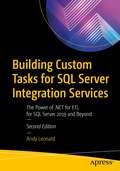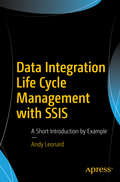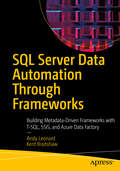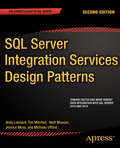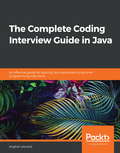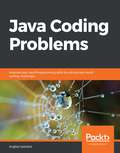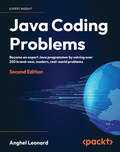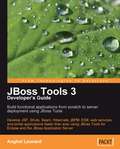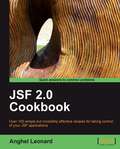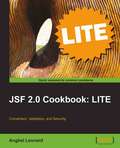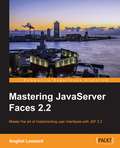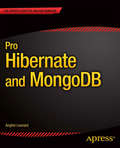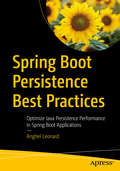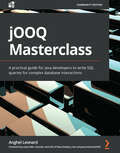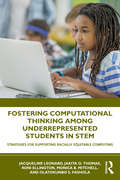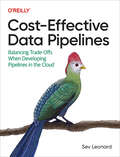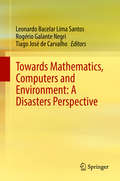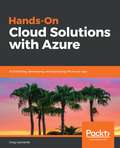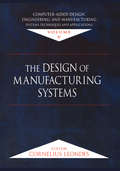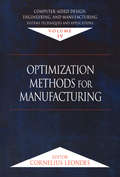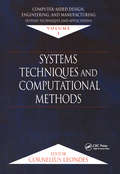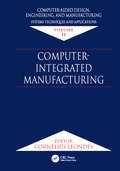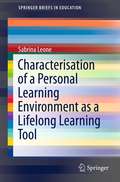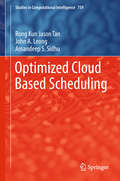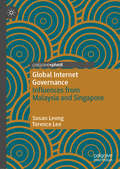- Table View
- List View
Building Custom Tasks for SQL Server Integration Services: The Power of .NET for ETL for SQL Server 2019 and Beyond
by Andy LeonardBuild custom SQL Server Integration Services (SSIS) tasks using Visual Studio Community Edition and C#. Bring all the power of Microsoft .NET to bear on your data integration and ETL processes, and for no added cost over what you’ve already spent on licensing SQL Server. New in this edition is a demonstration deploying a custom SSIS task to the Azure Data Factory (ADF) Azure-SSIS Integration Runtime (IR). All examples in this new edition are implemented in C#. Custom task developers are shown how to implement custom tasks using the widely accepted and default language for .NET development. Why are custom components necessary? Because even though the SSIS catalog of built-in tasks and components is a marvel of engineering, gaps remain in the available functionality. One such gap is a constraint of the built-in SSIS Execute Package Task, which does not allow SSIS developers to select SSIS packages from other projects in the SSIS Catalog. Examples in this book show how to create a custom Execute Catalog Package task that allows SSIS developers to execute tasks from other projects in the SSIS Catalog. Building on the examples and patterns in this book, SSIS developers may create any task to which they aspire, custom tailored to their specific data integration and ETL needs. What You Will LearnConfigure and execute Visual Studio in the way that best supports SSIS task developmentCreate a class library as the basis for an SSIS task, and reference the needed SSIS assembliesProperly sign assemblies that you create in order to invoke them from your taskImplement source code control via Azure DevOps, or your own favorite tool setTroubleshoot and execute custom tasks as part of your own projectsCreate deployment projects (MSIs) for distributing code-complete tasksDeploy custom tasks to Azure Data Factory Azure-SSIS IRs in the cloudCreate advanced editors for custom task parametersWho This Book Is ForFor database administrators and developers who are involved in ETL projects built around SQL Server Integration Services (SSIS). Readers do not need a background in software development with C#. Most important is a desire to optimize ETL efforts by creating custom-tailored tasks for execution in SSIS packages, on-premises or in ADF Azure-SSIS IRs.
Data Integration Life Cycle Management with SSIS: A Short Introduction By Example
by Andy LeonardBuild a custom BimlExpress framework that generates dozens of SQL Server Integration Services (SSIS) packages in minutes. Use this framework to execute related SSIS packages in a single command. You will learn to configure SSIS catalog projects, manage catalog deployments, and monitor SSIS catalog execution and history. Data Integration Life Cycle Management with SSIS shows you how to bring DevOps benefits to SSIS integration projects. Practices in this book enable faster time to market, higher quality of code, and repeatable automation. Code will be created that is easier to support and maintain. The book teaches you how to more effectively manage SSIS in the enterprise environment by drawing on the art and science of modern DevOps practices. What You'll Learn Generate dozens of SSIS packages in minutes to speed your integration projects Reduce the execution of related groups of SSIS packages to a single command Successfully handle SSIS catalog deployments and their projects Monitor the execution and history of SSIS catalog projects Manage your enterprise data integration life cycle through automated tools and utilities Who This Book Is For Database professionals working with SQL Server Integration Services in enterprise environments. The book is especially useful to those readers following, or wishing to follow, DevOps practices in their use of SSIS.
SQL Server Data Automation Through Frameworks: Building Metadata-Driven Frameworks with T-SQL, SSIS, and Azure Data Factory
by Andy Leonard Kent BradshawLearn to automate SQL Server operations using frameworks built from metadata-driven stored procedures and SQL Server Integration Services (SSIS). Bring all the power of Transact-SQL (T-SQL) and Microsoft .NET to bear on your repetitive data, data integration, and ETL processes. Do this for no added cost over what you’ve already spent on licensing SQL Server. The tools and methods from this book may be applied to on-premises and Azure SQL Server instances. The SSIS framework from this book works in Azure Data Factory (ADF) and provides DevOps personnel the ability to execute child packages outside a project—functionality not natively available in SSIS.Frameworks not only reduce the time required to deliver enterprise functionality, but can also accelerate troubleshooting and problem resolution. You'll learn in this book how frameworks also improve code quality by using metadata to drive processes. Much of the work performed by data professionals can be classified as “drudge work”—tasks that are repetitive and template-based. The frameworks-based approach shown in this book helps you to avoid that drudgery by turning repetitive tasks into "one and done" operations. Frameworks as described in this book also support enterprise DevOps with built-in logging functionality.What You Will LearnCreate a stored procedure framework to automate SQL process executionBase your framework on a working system of stored procedures and execution loggingCreate an SSIS framework to reduce the complexity of executing multiple SSIS packagesDeploy stored procedure and SSIS frameworks to Azure Data Factory environments in the cloudWho This Book Is ForDatabase administrators and developers who are involved in enterprise data projects built around stored procedures and SQL Server Integration Services (SSIS). Readers should have a background in programming along with a desire to optimize their data efforts by implementing repeatable processes that support enterprise DevOps.
SQL Server Integration Services Design Patterns
by Andy Leonard Tim Mitchell Matt Masson Jessica Moss Michelle UffordSQL Server Integration Services Design Patterns is newly-revised for SQL Server 2014, and is a book of recipes for SQL Server Integration Services (SSIS). Design patterns in the book help to solve common problems encountered when developing data integration solutions. The patterns and solution examples in the book increase your efficiency as an SSIS developer, because you do not have to design and code from scratch with each new problem you face. The book's team of expert authors take you through numerous design patterns that you'll soon be using every day, providing the thought process and technical details needed to support their solutions. SQL Server Integration Services Design Patterns goes beyond the surface of the immediate problems to be solved, delving into why particular problems should be solved in certain ways. You'll learn more about SSIS as a result, and you'll learn by practical example. Where appropriate, the book provides examples of alternative patterns and discusses when and where they should be used. Highlights of the book include sections on ETL Instrumentation, SSIS Frameworks, Business Intelligence Markup Language, and Dependency Services. Takes you through solutions to common data integration challengesProvides examples involving Business Intelligence Markup LanguageTeaches SSIS using practical examples
The Complete Coding Interview Guide in Java: An effective guide for aspiring Java developers to ace their programming interviews
by Anghel LeonardExplore a wide variety of popular interview questions and learn various techniques for breaking down tricky bits of code and algorithms into manageable chunks Key Features Discover over 200 coding interview problems and their solutions to help you secure a job as a Java developer Work on overcoming coding challenges faced in a wide array of topics such as time complexity, OOP, and recursion Get to grips with the nuances of writing good code with the help of step-by-step coding solutions Book Description Java is one of the most sought-after programming languages in the job market, but cracking the coding interview in this challenging economy might not be easy. This comprehensive guide will help you to tackle various challenges faced in a coding job interview and avoid common interview mistakes, and will ultimately guide you toward landing your job as a Java developer. This book contains two crucial elements of coding interviews - a brief section that will take you through non-technical interview questions, while the more comprehensive part covers over 200 coding interview problems along with their hands-on solutions. This book will help you to develop skills in data structures and algorithms, which technical interviewers look for in a candidate, by solving various problems based on these topics covering a wide range of concepts such as arrays, strings, maps, linked lists, sorting, and searching. You'll find out how to approach a coding interview problem in a structured way that produces faster results. Toward the final chapters, you'll learn to solve tricky questions about concurrency, functional programming, and system scalability. By the end of this book, you'll have learned how to solve Java coding problems commonly used in interviews, and will have developed the confidence to secure your Java-centric dream job. What you will learn Solve the most popular Java coding problems efficiently Tackle challenging algorithms that will help you develop robust and fast logic Practice answering commonly asked non-technical interview questions that can make the difference between a pass and a fail Get an overall picture of prospective employers' expectations from a Java developer Solve various concurrent programming, functional programming, and unit testing problems Who this book is for This book is for students, programmers, and employees who want to be invited to and pass interviews given by top companies. The book assumes high school mathematics and basic programming knowledge.
Java Coding Problems: Improve your Java Programming skills by solving real-world coding challenges
by Anghel LeonardDevelop your coding skills by exploring Java concepts and techniques such as Strings, Objects and Types, Data Structures and Algorithms, Concurrency, and Functional programming Key Features Solve Java programming challenges and get interview-ready by using the power of modern Java 11 Test your Java skills using language features, algorithms, data structures, and design patterns Explore areas such as web development, mobile development, and GUI programming Book Description The super-fast evolution of the JDK between versions 8 and 12 has increased the learning curve of modern Java, therefore has increased the time needed for placing developers in the Plateau of Productivity. Its new features and concepts can be adopted to solve a variety of modern-day problems. This book enables you to adopt an objective approach to common problems by explaining the correct practices and decisions with respect to complexity, performance, readability, and more. Java Coding Problems will help you complete your daily tasks and meet deadlines. You can count on the 300+ applications containing 1,000+ examples in this book to cover the common and fundamental areas of interest: strings, numbers, arrays, collections, data structures, date and time, immutability, type inference, Optional, Java I/O, Java Reflection, functional programming, concurrency and the HTTP Client API. Put your skills on steroids with problems that have been carefully crafted to highlight and cover the core knowledge that is accessed in daily work. In other words (no matter if your task is easy, medium or complex) having this knowledge under your tool belt is a must, not an option. By the end of this book, you will have gained a strong understanding of Java concepts and have the confidence to develop and choose the right solutions to your problems. What you will learn Adopt the latest JDK 11 and JDK 12 features in your applications Solve cutting-edge problems relating to collections and data structures Get to grips with functional-style programming using lambdas Perform asynchronous communication and parallel data processing Solve strings and number problems using the latest Java APIs Become familiar with different aspects of object immutability in Java Implement the correct practices and clean code techniques Who this book is for If you are a Java developer who wants to level-up by solving real-world problems, then this book is for you. Working knowledge of Java is required to get the most out of this book.
Java Coding Problems: Become an expert Java programmer by solving over 250 brand-new, modern, real-world problems
by Anghel LeonardStay on top of the new Java features (up to JDK 21) and find efficient solutions for your programming woes. With over 250 problems and solutions, you'll learn new ways to deal with real-world coding tasks and answers to common interview questions. Purchase of the print or Kindle book includes a free PDF eBookKey FeaturesSolve Java programming challenges and get interview-ready with the power of modern Java 21Test your Java skills using language features, algorithms, data structures, and design patternsExplore tons of examples, all fully refreshed for this edition, meant to help you accommodate JDK 12 to JDK 21Book DescriptionThe super-fast evolution of the JDK between versions 12 and 21 has made the learning curve of modern Java steeper, and increased the time needed to learn it. This book will make your learning journey quicker and increase your willingness to try Java’s new features by explaining the correct practices and decisions related to complexity, performance, readability, and more. Java Coding Problems takes you through Java’s latest features but doesn’t always advocate the use of new solutions — instead, it focuses on revealing the trade-offs involved in deciding what the best solution is for a certain problem. There are more than two hundred brand new and carefully selected problems in this second edition, chosen to highlight and cover the core everyday challenges of a Java programmer. Apart from providing a comprehensive compendium of problem solutions based on real-world examples, this book will also give you the confidence to answer questions relating to matching particular streams and methods to various problems. By the end of this book you will have gained a strong understanding of Java’s new features and have the confidence to develop and choose the right solutions to your problems.What you will learnAdopt the latest JDK 21 features in your applicationsExplore Records, Record Patterns, Record serialization and so onWork with Sealed Classes and Interfaces for increasing encapsulationLearn how to exploit Context-Specific Deserialization FiltersSolve problems relating to collections and esoteric data structuresLearn advanced techniques for extending the Java functional APIExplore the brand-new Socket API and Simple Web ServerTackle modern Garbage Collectors and Dynamic CDS ArchivesWho this book is forIf you are a Java developer who wants to level-up by solving real-world problems, then this book is for you. Working knowledge of the Java programming language is required to get the most out of this book
JBoss Tools 3 Developers Guide
by Anghel LeonardSince these technologies covered are different from each other, they are covered in separate chapters that are not interdependent; therefore you can learn to use whichever tool you want, without exploring the previous chapters. This approach sustains the learning per example paradigm and helps you to use the book as a quick guide for your favorite technologies. This book is recommended for Java developers who use at least one of the covered technologies (JSF, Struts, Hibernate, Seam, and so on). It is for all Java developers who are looking for a powerful, unitary tool, especially designed to increase the speed of development and quality of Java web applications. No matter how much (or how little) experience they have, developers of all levels will benefit as their use of JBoss Tools is directly proportional to the complexity of their application. Since JBoss Tools covers all levels of experience, you can use it at your own level for your own applications, without involving unnecessary features. All you need is to be familiar with the Eclipse environment and Java core, and to have some expertise in the technology for which you want to use the JBoss Tools. Basic expertise for each technology is provided in the book, but for more complete and detailed aspects you should read dedicated specifications, tutorials, and articles.
JSF 2.0 Cookbook
by Anghel LeonardThe JSF 2.0 Cookbook contains step-by-step instructions for JSF users to build desktop-style interfaces in their own web applications. The book is designed so that you can refer to it chapter by chapter, or you can look at the list of recipes and read them in no particular order. This book is for two types of audience: Newcomers who know the basics of JSF but are yet to develop real JSF applications., JSF developers who have previous experience but are lacking best practices and a standard way of implementing functionality
JSF 2.0 Cookbook: LITE
by Anghel LeonardPractical, hands-on "Cookbook" approach. Full of clear, step-by-step instructions that you can apply straight away. Written for people who want to get maximum results without lots of background and theory reading. JSF developers who want to work with validators, converters and security features of JSF. You don't need any prior knowledge of JSF to use these recipes.
Mastering JavaServer Faces 2.2
by Anghel LeonardA homogenous guide integrating the features of JSF 2.x (2.0, 2.1 and 2.2), following a "learning through examples" paradigm with its main focus on the advanced concepts of JSF. If you are a web developer who uses JSF, this is the book for you. Catering to an intermediate-advanced audience, the book assumes you have fundamental knowledge of JSF. It is intended for the developer who wants to improve their skills with the combined power of JSF 2.0, 2.1, and 2.2.
Pro Hibernate and MongoDB
by Anghel LeonardHibernate and MongoDB are a powerful combination of open source persistence and NoSQL technologies for today's Java-based enterprise and cloud application developers. Hibernate is the leading open source Java-based persistence, object relational management engine, recently repositioned as an object grid management engine. MongoDB is a growing, popular open source NoSQL framework, especially popular among cloud application and big data developers. With these two, enterprise and cloud developers have a "complete out of the box" solution. Pro Hibernate and MongoDB shows you how to use and integrate Hibernate and MongoDB. More specifically, this book guides you through the bootstrap; building transactions; handling queries and query entities; and mappings. Then, this book explores the principles and techniques for taking these application principles to the cloud, using the OpenShift Platform as a Service (PaaS) and more. In this book, you get two case studies: An enterprise application using Hibernate and MongoDB. then, A cloud application (OpenShip) migrated from the enterprise application case study After reading or using this book, you come away with the experience from two case studies that give you possible frameworks or templates that you can apply to your own specific application or cloud application building context.
Spring Boot Persistence Best Practices: Optimize Java Persistence Performance in Spring Boot Applications
by Anghel LeonardThis book is a collection of developer code recipes and best practices for persisting data using Spring, particularly Spring Boot. The book is structured around practical recipes, where each recipe discusses a performance case or performance-related case, and almost every recipe has one or more applications. Mainly, when we try to accomplish something (e.g., read some data from the database), there are several approaches to do it, and, in order to choose the best way, you have to know the implied trades-off from a performance perspective. You’ll see that in the end, all these penalties slow down the application. Besides presenting the arguments that favor a certain choice, the application is written in Spring Boot style which is quite different than plain Hibernate. Persistence is an important set of techniques and technologies for accessing and using data, and this book demonstrates that data is mobile regardless of specific applications and contexts. In Java development, persistence is a key factor in enterprise, ecommerce, cloud and other transaction-oriented applications. After reading and using this book, you'll have the fundamentals to apply these persistence solutions into your own mission-critical enterprise Java applications that you build using Spring. What You Will Learn Shape *-to-many associations for best performancesEffectively exploit Spring Projections (DTO) Learn best practices for batching inserts, updates and deletes Effectively fetch parent and association in a single SELECTLearn how to inspect Persistent Context contentDissect pagination techniques (offset and keyset)Handle queries, locking, schemas, Hibernate types, and more Who This Book Is For Any Spring and Spring Boot developer that wants to squeeze the persistence layer performances.
jOOQ Masterclass: A practical guide for Java developers to write SQL queries for complex database interactions
by Anghel Leonard Lukas EderLearn the best way to write SQL in Java by taking control of SQL in your app via a type-safe, dynamic and versatile API that supports almost any type or feature compatible with a database and emphasizes SQL syntax correctnessKey FeaturesWrite complex, type-safe, and dynamic SQL using the powerful jOOQ APITackle complex persistence tasks, such as lazy fetching, R2DBC, transactions, and batching while sustaining high traffic in your modern Java applicationsUse a comprehensive SPI to shape and extend jOOQ according to your needsBook DescriptionjOOQ is an excellent query builder framework that allows you to emulate database-specific SQL statements using a fluent, intuitive, and flexible DSL API. jOOQ is fully capable of handling the most complex SQL in more than 30 different database dialects.jOOQ Masterclass covers jOOQ from beginner to expert level using examples (for MySQL, PostgreSQL, SQL Server, and Oracle) that show you how jOOQ is a mature and complete solution for implementing the persistence layer. You'll learn how to use jOOQ in Spring Boot apps as a replacement for SpringTemplate and Spring Data JPA. Next, you'll unleash jOOQ type-safe queries and CRUD operations via jOOQ's records, converters, bindings, types, mappers, multi-tenancy, logging, and testing. Later, the book shows you how to use jOOQ to exploit powerful SQL features such as UDTs, embeddable types, embedded keys, and more. As you progress, you'll cover trending topics such as identifiers, batching, lazy loading, pagination, and HTTP long conversations. For implementation purposes, the jOOQ examples explained in this book are written in the Spring Boot context for Maven/Gradle against MySQL, Postgres, SQL Server, and Oracle.By the end of this book, you'll be a jOOQ power user capable of integrating jOOQ in the most modern and sophisticated apps including enterprise apps, microservices, and so on.What you will learnEnable the jOOQ Code Generator in any combination of Java and Kotlin, Maven and GradleGenerate jOOQ artifacts directly from database schema, or without touching the real databaseUse jOOQ DSL to write and execute a wide range of queries for different databasesUnderstand jOOQ type-safe queries, CRUD operations, converters, bindings, and mappersImplement advanced SQL concepts such as stored procedures, derived tables, CTEs, window functions, and database viewsImplement jOOQ multi-tenancy, tuning, jOOQ SPI, logging, and testingWho this book is forThis book is for Java developers who write applications that interact with databases via SQL. No prior experience with jOOQ is assumed.
Fostering Computational Thinking Among Underrepresented Students in STEM: Strategies for Supporting Racially Equitable Computing
by Jacqueline Leonard Jakita O. Thomas Roni Ellington Monica B. Mitchell Olatokunbo S. FasholaThis book broadly educates preservice teachers and scholars about current research on computational thinking (CT). More specifically, attention is given to computational algorithmic thinking (CAT), particularly among underrepresented K–12 student groups in STEM education. Computational algorithmic thinking (CAT)—a precursor to CT—is explored in this text as the ability to design, implement, and evaluate the application of algorithms to solve a variety of problems. Drawing on observations from research studies that focused on innovative STEM programs, including underrepresented students in rural, suburban, and urban contexts, the authors reflect on project-based learning experiences, pedagogy, and evaluation that are conducive to developing advanced computational thinking, specifically among diverse student populations. This practical text includes vignettes and visual examples to illustrate how coding, computer modeling, robotics, and drones may be used to promote CT and CAT among students in diverse classrooms.
Cost-Effective Data Pipelines
by Sev LeonardThe low cost of getting started with cloud services can easily evolve into a significant expense down the road. That's challenging for teams developing data pipelines, particularly when rapid changes in technology and workload require a constant cycle of redesign. How do you deliver scalable, highly available products while keeping costs in check?With this practical guide, author Sev Leonard provides a holistic approach to designing scalable data pipelines in the cloud. Intermediate data engineers, software developers, and architects will learn how to navigate cost/performance trade-offs and how to choose and configure compute and storage. You'll also pick up best practices for code development, testing, and monitoring.By focusing on the entire design process, you'll be able to deliver cost-effective, high-quality products. This book helps you:Reduce cloud spend with lower cost cloud service offerings and smart design strategiesMinimize waste without sacrificing performance by rightsizing compute resourcesDrive pipeline evolution, head off performance issues, and quickly debug with effective monitoringSet up development and test environments that minimize cloud service dependenciesCreate data pipeline code bases that are testable and extensible, fostering rapid development and evolutionImprove data quality and pipeline operation through validation and testing
Towards Mathematics, Computers and Environment: A Disasters Perspective
by Leonardo Bacelar Lima Santos Rogério Galante Negri Tiago José de CarvalhoWith relevant, timely topics, this book gathers carefully selected, peer-reviewed scientific works and offers a glimpse of the state-of-the-art in disaster prevention research, with an emphasis on challenges in Latin America. Topics include studies on surface frost, an extreme meteorological event that occasionally affects parts of Argentina, Bolivia, Peru, and southern Brazil, with serious impacts on local economies; near-ground pollution concentration, which affects many industrial, overpopulated cities within Latin America; disaster risk reduction and management, which are represented by mathematical models designed to assess the potential impact of failures in complex networks; and the intricate dynamics of international armed conflicts, which can be modeled with the help of stochastic theory. The book offers a valuable resource for professors, researchers, and students from both mathematical and environmental sciences, civil defense coordinators, policymakers, and stakeholders.
Hands-On Cloud Solutions with Azure: Architecting, developing, and deploying the Azure way
by Greg LeonardoDesign effective Azure architecture and transform your IT business solutionsKey FeaturesDevelop a resilient and robust cloud environmentDeploy and manage cost-effective and highly available solutions on your public cloudDesign and implement enterprise-level cloud solutionsBook DescriptionAzure provides cloud-based solutions to support your business demands. Building and running solutions on Azure will help your business maximize the return on investment and minimize the total cost of ownership.Hands-On Cloud Solutions with Azure focuses on addressing the architectural decisions that usually arise when you design or migrate a solution to Microsoft Azure. You will start by designing the building blocks of infrastructure solution on Azure, such as Azure compute, storage, and networking, followed by exploring the database options it offers. You will get to grips with designing scalable web and mobile solutions and understand where to host your Active Directory and Identity Solution. Moving on, you’ll learn how to extend DevOps to Azure.You will also beneft from some exciting services that enable extremely smooth operations and streamlined DevOps between on-premises and cloud. The book will help you to design a secure environment for your solution, on both the Cloud and hybrid. Toward the end, you’ll see how to manage and monitor cloud and hybrid solutions.By the end of this book, you will be armed with all the tools and knowledge you need to properly plan and design your solutions on Azure, whether it’s for a brand new project or migration project.What you will learnGet started with Azure by understanding tenants, subs, and resource groupsDecide whether to “lift and shift” or migrate appsPlan and architect solutions in AzureBuild ARM templates for Azure resourcesDevelop and deploy solutions in AzureUnderstand how to monitor and support your application with AzureMake your life easier with Azure best practices and tipsWho this book is forIf you’re an IT consultant, developer, or solutions architect looking to design effective solutions for your organization, this book is for you. Some knowledge of cloud computing will assist with understanding the key concepts covered in this book.
Computer-Aided Design, Engineering, and Manufacturing: Systems Techniques and Applications, Volume V, The Design of Manufacturing Systems
by Cornelius LeondesIn the competitive business arena companies must continually strive to create new and better products faster, more efficiently, and more cost effectively than their competitors to gain and keep the competitive advantage. Computer-aided design (CAD), computer-aided engineering (CAE), and computer-aided manufacturing (CAM) are now the industry standa
Computer-Aided Design, Engineering, and Manufacturing: Systems Techniques and Applications, Volume IV, Optimization Methods for Manufacturing
by Cornelius LeondesIn the competitive business arena companies must continually strive to create new and better products faster, more efficiently, and more cost effectively than their competitors to gain and keep the competitive advantage. Computer-aided design (CAD), computer-aided engineering (CAE), and computer-aided manufacturing (CAM) are now the industry standa
Computer-Aided Design, Engineering, and Manufacturing: Systems Techniques and Applications, Volume I, Systems Techniques and Computational Methods
by Cornelius LeondesIn the competitive business arena organizations must continually strive to create new and better products faster, more efficiently, and more cost effectively than competitors to gain and keep the competitive advantage. Computer-aided design (CAD), computer-aided engineering (CAE), and computer-aided manufacturing (CAM) are now the industry standard, in all major industries. The seven volumes in Computer-Aided Design, Engineering, and Manufacturing: Systems Techniques, and Manufacturing provide a comprehensive treatment of the techniques and applications of CAD, CAE, and CAM.
Computer-Aided Design, Engineering, and Manufacturing: Systems Techniques and Applications, Volume II, Computer-Integrated Manufacturing
by Cornelius T. LeondesIn the competitive business arena companies must continually strive to create new and better products faster, more efficiently, and more cost effectively than their competitors to gain and keep the competitive advantage. Computer-aided design (CAD), computer-aided engineering (CAE), and computer-aided manufacturing (CAM) are now the industry standa
Characterisation of a Personal Learning Environment as a Lifelong Learning Tool (SpringerBriefs in Education)
by Sabrina LeoneThis work focuses on the characterization of adult lifelong learners' Personal Learning Environments (PLEs) by implicit and explicit tools of personalization. It aims aims toward creating a system for the development of a learning path for the characterisation of PLE for adult life learners. The synergy of formal and informal learning in the dynamic construction of a lifelong learner's PLE is fully explored, with the recognition that the majority of learning, especially for life long learners, occurs outside traditional learning formats. Specifically, this volume discusses the design, implementation, and validation of the SSW4LL (Social Semantic Web for Lifelong Learners) format, and the the SSW4LL system, built on Moodle 2.0 integrated with an adaptive mechanism (conditional activities) and some tools of Social Semantic Web (Semantic MediaWiki, Diigo and Google+). With thoroughly grounded cases studies, this volume makes the case that these systems are suitable to provide a dynamically personalized learning environment to the lifelong learner. All of these environments are fully discussed and cases made for each as a tool for constructing adult learners' PLEs.
Optimized Cloud Based Scheduling (Studies In Computational Intelligence #759)
by John A. Leong Amandeep S. Sidhu Rong Kun TanThis book presents an improved design for service provisioning and allocation models that are validated through running genome sequence assembly tasks in a hybrid cloud environment. It proposes approaches for addressing scheduling and performance issues in big data analytics and showcases new algorithms for hybrid cloud scheduling. Scientific sectors such as bioinformatics, astronomy, high-energy physics, and Earth science are generating a tremendous flow of data, commonly known as big data. In the context of growing demand for big data analytics, cloud computing offers an ideal platform for processing big data tasks due to its flexible scalability and adaptability. However, there are numerous problems associated with the current service provisioning and allocation models, such as inefficient scheduling algorithms, overloaded memory overheads, excessive node delays and improper error handling of tasks, all of which need to be addressed to enhance the performance of big data analytics.
Global Internet Governance: Influences from Malaysia and Singapore
by Susan Leong Terence LeeThis book addresses the complex issue of global Internet governance by focusing on its implementation in Malaysia and Singapore. The authors draw insights, identify, revisit and flesh out the discourses circulating since the 1990s and pitch them against global internet governance concerns.Internet governance, thought managed domestically/nationally, is a global issue. It is at the heart of how the internet works yet remains hidden within the 'black box' of governance language. While several scholars have entered the fray in recent years, especially in the past decade, very few of them are aware that the Malaysian and Singaporean governments have in fact been at the forefront of Internet regulatory strategies from the early 1990s. The book identifies, revisits and gives flesh to some of the discourses circulating in Southeast Asia at the time and pitches it against current governance concerns. Readers of this book will understand how and why Malaysia and Singapore are important contributors to the issue of internet governance. This knowledge will inform a depth of understanding of why China is keenly seeking to stake its demands on internet governance and sovereignty, and likely American and global responses. Readers will also appreciate how and why the regulation of the Internet has been and will remain a site of contestation and control.
